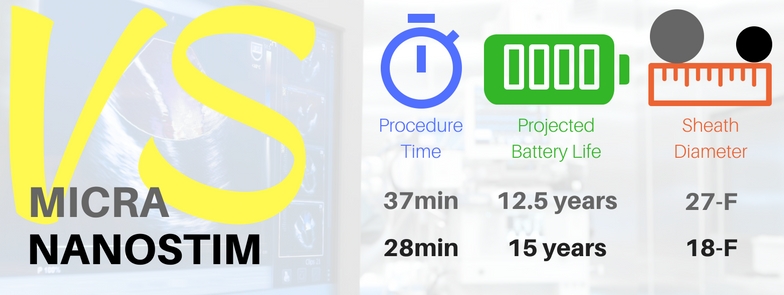On the back of encouraging Phase III trial results, Medtronic's "Micra" leadless pacemaker was approved by the U.S. Food and Drug Administration in April, beating St. Jude Medical's "Nanostim" to approval—but does it have more limitations?
For leadless pacemakers, size matters.
Despite being small for pacemakers, both devices are rather large for transfemoral catheterization—the access site for both devices.
Sheaths for St. Jude Medical's Nanostim device measure 18 French or 6mm in diameter, to which Dr. Prapa Kanagaratnam of St. Mary's Hospital, Imperial College, London expressed some concern. "An 18-F sheath is a big sheath to put in the leg," he said to heartwire.
"A lot of the patients we're putting these devices into are small, elderly people," said Dr. Kanagaratnam. "So it's still a procedure that we feel anxious about."
Micra is shorter but wider than Nanostim, with sheaths measuring 27-F or 8.333mm in diameter, which could be a negative despite being smaller than Nanostim overall—0.8cm3 compared to 1cm3.
Perhaps Micra's larger sheath diameter contributed to procedural times that were longer, on average, than Nanostim's—37 minutes compared to 28 minutes1—though procedural times were likely affected negatively by a learning curve in both studies.
Cost-effectiveness of leadless pacemakers remains to be seen.
Procedural time could become an all-important factor for the expensive devices. Medtronic's Micra was estimated to cost around $10,000—whereas traditional pacemakers average $2,500—on the assumption that savings in surgical costs would make it cost-effective.
Even slightly shorter procedural times could tip the scales in favor of one device over the other, where efficiency is the name of the game.
Pricing and cost-effectiveness of the two devices could also hinge on expected battery life, an area where doctors expect Nanostim to have an edge.
"Nanostim has a better chance of being longer-lasting, and that is because if you want to communicate with the Micra pacemaker you need RF communication, and that costs a lot of energy." said Dr. Reinoud Knops, Academic Medical Center, Amsterdam to heartwire.
"Nanostim uses your own body as an antenna and that conductive communication is very energy efficient, and the predictions of the battery longevity of Nanostim look much better," said Dr. Knops.
Battery life in the Micra is projected to last an average of 12.5 years2 against an average of 15 years3 in the Nanostim.

| Device | Micra | Nanostim |
| Average Procedural Time | 37 minutes1 | 28 minutes1 |
| Mean Proj. Battery Longevity | 12.5 years2 | 15 years3 |
| Sheath Diameter | 27-F4 | 18-F4 |
Device removal might also be a decisive factor.
But what happens if the devices need to be removed before battery life is up? Nanostim, again, might have an edge.
In May, it was announced that "the Nanostim leadless pacemaker was successfully retrieved in 14 patients up to 3.2 years post-implantation without any serious adverse events."
Though the design and material of Micra enables it to be taken out when needed, the intended end-of-life scenario is for it to be left in the body, according to Modern Healthcare.
Perhaps Medtronic rightly expects the device to be fully encapsulated by tissue by the end of its battery life.
At the three year mark, however, design elements in Nanostim aimed at minimizing tissue ingrowth—its docking mechanism or "solid titanium housing," for example—left the pacemakers "strikingly clean," said Dr. Knops to heartwire.
"Especially the one that was implanted for 3 years," said Dr. Knops. "There was almost no tissue on the pacemaker or the helix."
But in one patient where the pacemaker was implanted for less time—more than 1 year—a "thin fibrotic cap" indicating encapsulation was apparent after retrieval.
Maybe chances of encapsulation are just too high at the fifteen year mark for even Nanostim to be removed at end-of-life.
Caveats rule the day.
Of course, many would argue it is still impossible to measure the two leadless pacemakers against each other, since they haven't been studied in a head-to-head randomized, controlled trial.
But the questionable feasibility of such a study—where the relevant patient population is already small and would have to be split into even smaller subgroups—means we might never have true head-to-head data.
TL;DR?
While Medtronic's Micra might hold the title of the "smallest" leadless pacemaker, St. Jude Medical's claims at "longest-lasting leadless pacemaker with the industry's least invasive and smallest delivery system" do seem to hold water.
Of course, both devices have shown promising outcomes—the decision might rest entirely on cost.
What do you think? Leave a comment!

The information presented was useful, and provided good discussion of some points of difference between lead-type and lead-less pacemakers, (Micra and Nanostim). The obvious omission is how health insurance companies view the big cost differential between lead-type ($2500) and lead-less pacemakers (around $10,000)?
A head-to-head study between Nanostim and Micra may also be useful. But, that would probably take several years to produce.
Regarding both “in production devices as the Nanostim and the Micra (as a potential recipient,) I am concerned about the problems associated within a “welding” environment. Also if both are OK for the CT and MRI environment what about the relationship to microwaves and the exposure to induction cooktops etc…..
Any response would be greatly appreciated as I have some decisions to make…thank You
Hi Norman,
This blog was written without comment or direct contact with either manufacturer, but I have found some information in materials from both that can answer your question regarding household devices.
It looks like either company’s guidance for physicians discussed CT and MRI environments, but not microwaves, etc. However, their patient guidance materials did have this information.
Micra’s website suggests that household appliances “that are properly maintained and in good working order are safe. This includes microwave ovens, major appliances, electric blankets, and heating pads.” Nanostim resources have a similar statement: “Most home appliances and office equipment in good working order are safe to use (microwave ovens, blenders, toasters, electric knives, televisions, electric blankets, stoves, garage door openers).” Though it also says: “The pacemaker will work properly with most medical equipment during x-rays, diagnostic ultrasound, CT scans, mammography, and fluoroscopy. It is also MRI conditional. You should do your best to avoid electromagnetic interferences (EMI) that could be caused by electrical appliances in poor conditions or not grounded correctly, industrial generators, arc-welders, specific medical equipment. Magnets, large heaters and radio transmitters also can cause EMI.”
You can find this quotation in the “Nanostim Patient Education Handbook” or the Micra Transcatheter Pacing System “FAQs.”
Of course, St. Jude recently announced battery issues with the Nanostim affecting 0.5% of patients, which might also affect your decision if time is of the essence.
Let me know if I can be of any further assistance, and thank you for your comment—I’m glad you found ACVP’s blog.
Hello.
1. What is the patient charge for the Micra Pacer and the Nanostim Pacer?
2. Regarding electronic interference in our environment: Cell Phones: Microwaves: Weather Lightning Bolts: Electrical Shocks from household current: Highway Traffic Control Electronics to name a few potential sources of electronic interference. Is there any data available?
Any comments should have some reply from the manufacturers regarding the problems listed thanks
Maybe this technology needs more research before putting peoples lives at risk:
https://www.tga.gov.au/alert/nanostim-leadless-cardiac-pacemaker